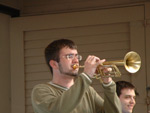|
|
|
 DYLAN CANTERBURY DYLAN CANTERBURY
trumpeter
Instead of doing just one list, I’m going to do two: a top five of “obvious” picks and a top five of “less obvious” picks.
The “Obvious” Ones:
1. Louis Armstrong, “The Complete Hot Fives and Hot Sevens”
The most important recordings by the most important jazz artist. Although there are plenty of notable moments from some of jazz’s earliest figureheads on this set, Pops’ performances continually stand out above the rest. From his iconic cadenza on “West End Blues” to the stop-time virtuosity of “Cornet Chop Suey” to his incomparable duet with pianist Earl Hines on “Weather Bird,” these recordings serve as a constant reminder of why I decided to pursue a life in music.
2. Miles Davis, “Kind Of Blue”
What is there to say about this album that hasn’t already been said a million times before? Six of jazz’s superstars working together in a perfectly cohesive setting, all playing at the peak of their powers, performing music that completely revolutionized the way the world thought about improvising. Even the standard blues and AABA forms were given a liberating overhaul via the more open-ended modal harmonies explored on this recording. The only downfall is thinking what this band could have done if they had stayed together longer…
3.
John Coltrane, “A Love Supreme”
The culmination of Trane’s spiritual quest is also the greatest of his many great recordings. The whole quartet shines throughout, both through each member’s individual performances as well as their unity as a group. But for every exciting McCoy Tyner flourish or Elvin Jones thunder clap, everything comes back to Trane, whose playing throughout is nothing short of exhilarating. This album is truly a liberating experience, both musically and emotionally; it never fails to shock and awe this listener.
4.
Duke Ellington, “Such Sweet Thunder”
It only seems appropriate that a cross-age collaboration between the conceptual brilliance of Duke Ellington and the timeless works of William Shakespeare would produce results as stellar as this. The way Duke and Billy Strayhorn cast the many illustrious band members into some of the Bard’s classic roles is nothing short of genius (personal favorites include Johnny Hodges and Paul Gonsalves as Romeo and Juliet and Clark Terry as Puck). There’s not a boring moment to be found on this one.
5. Ornette Coleman, “The Shape Of Jazz To Come"
I’ve always believed that the best way to get into Ornette Coleman’s music is to ignore its intrinsic “weirdness” and focus more on the incoherent-blues-singer approach to the saxophone Coleman employs on a regular basis. There’s no better display of that style than this controversial (then and now) recording. The quirky but devilishly fun compositions and brilliantly like-minded supporting cast only add fuel to this off-kilter but endlessly entertaining musical fire.
The “Less Obvious” Ones:
1. Ahmad Jamal, “Chamber Music Of The New Jazz”
Go listen to the tracks “New Rhumba” and “I Don’t Wanna Be Kissed,” then listen to Miles Davis’ versions of the same songs on “Miles Ahead.” Do they sound familiar? They should. Jamal’s unmistakably deft piano touch provides a perfect interpretive vessel for the many standards on this recording, and his near-telepathic rapport with guitarist Ray Crawford and bassist Israel Crosby shows that you don’t need to have a drummer to keep great time. The crowning achievement of one of jazz’s great unsung heroes.
2.
Miles Davis, “Nefertiti”
The second Miles Davis Quintet is my all-time favorite jazz group, and this record is the pinnacle of their time together in the mid-1960s. What made this group so brilliant was their ability to collectively stretch, obscure, circumvent and redefine just about every major convention of the jazz combo. This relentless spirit of experimentation oozes out of every nook and cranny of this album, starting with the improvisational role reversal of the title track. It certainly doesn’t hurt that every single tune is a bona-fide masterpiece, either.
3.
Charles Mingus, “The Black Saint And The Sinner Lady”
The ever-volatile bassist and composer essentially viewed this epic mini-suite as a musical autobiography (he even had his psychiatrist write a second set of liner notes to back him up on this claim). What Mingus unfortunately didn’t spend time talking about was the process through which he developed this four-part musical roller coaster ride through the tortured soul of a mad genius. This work ranks right up there with the best works of Ellington in the halls of jazz composition.
4. Stan Getz, “Focus”
This isn’t your grandfather’s “jazz artist with strings” album. Getz completely throws out his usual shtick on this one in order to dive head first into composer Eddie Sauter’s intellectually demanding and adventurous charts, weaving his iconic saxophone sound through the thicket of strings in absolutely masterful ways. Combine this with the thrilling and dramatic interplay between Getz and drummer Roy Haynes on a few tracks, and you realize Getz was a hell of a lot more than that guy who did “The Girl from Ipanema.”
5. Sonny Rollins, “Newk’s Time”
I may be committing jazz sacrilege by saying this, but there are more than a few times when I find Sonny Rollins’ playing to be more exciting and thrilling than John Coltrane’s. This album is one of those times. Right from the get-go, Newk pulls out all the stops, engaging in a perennial interplay with drummer Philly Joe Jones, who spurs him along brilliantly throughout. Even after listening to it hundreds of times, this album continues to be nothing short of edge-of-your-seat exhilarating and unpredictable. |

